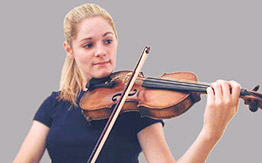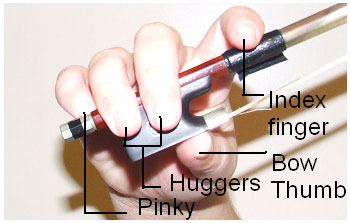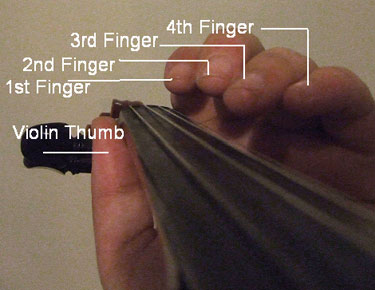How to Play the Violin
There are several methods that have been developed for students looking to learn how to play the violin. The most popular methods are the traditional and Suzuki methods. The traditional method is where the violinist reads music off a page, and is often started with children around 8 years old. The Suzuki method is a method where the student uses aural or listening skills to learn how to play, and is often started at 5 years of age, or even as early as 2. Both methods require a formal teacher, however some violinists self-learn. If you are endeavoring to learn the violin without a teacher, it is a good idea to find out as much information as you can about the violin, and watch and listen to other players as much as possible to get a feel for the instrument.
Learning how to play the violin is a long process. Take your time, relax, get into a good practicing routine, get to know your instrument and most of all - enjoy the process. If you are finding practicing a chore, move on and have a go at something else. Learning an instrument is always hard work, but it should never be frustrating or upsetting. Remember it's OK to have a break, just make sure you come back to it again later on.
- Correct Posture for Playing the Violin
- Violin Finger Names
- Practical Playing Tips for Beginners
- Advanced Playing Techniques
Correct Posture for Playing the Violin

Posture is very important when playing the violin to enhance the quality of the sound produced by the instrument, and to minimize possible muscle and back strain to the player. If you are just beginning to play the violin, spend as much time as you can getting your posture right first time around - bad habits can be hard to break, and require lots of un-learning!
The violin is held under the chin, in either a standing or sitting position. The best way to learn how to hold the violin properly is to watch a clip of a well-known violinist, and see how they hold their instrument.
Hold the violin and the bow loosely - if you hold either tightly, you will produce a 'tight' or scratchy sound.
Keep your joints unlocked (slightly bent) this includes your knees when standing! This helps to relax your main muscle groups when you play.
Try to use your tummy to hold you up as you play. If you focus holding your core tight (think about holding your belly button in) then you will produce a more intense, relaxed sound as the muscles in your arms and back will be more relaxed.
When you first think about playing the violin, most people think that it will be easier to play than it actually is. To play the violin well requires a lot of time and effort - you must be prepared to put in the quality practice required to be a good violinist.
To get the scratch out of your playing, instead of focusing on pressing the bow into the string, focus on gliding the bow across the string, like a dragonfly skimming across water. Focus intensely on this and your sound should become less scratchy. Scratch is produced when there is too much tension in the arms and hands, so be sure to relax as much as you can!
Don't press down too hard on the strings. Be firm, but remember the more relaxed you are, the more this will come through in the tone.
Play close to the bridge (about 2 bow width's from the bridge) this will produce the strongest, clearest sound possible on your violin. Always play with your bow moving parallel to the bridge - sideways movement across the string will cause a wispy sound.
Violin Finger Names
 |
 |
For beginner players, the names of the fingers that we refer to are as important to know as the parts of the violin.
The right hand is known as the bow hand (as this hand controls the bow), and the left the violin hand, which holds the violin. The fingers on both hands also have different names to differentiate them from one another. On the violin hand, the fingers are known as the violin thumb, and the 1st, 2nd, 3rd and 4th fingers (from thumb to pinky). You will often see numbers 1,2,3 or 4 above notes when reading written music, these numbers correspond to the names of the fingers you should use to play the note specified.
On the right hand the fingers are named slightly differently, according to the position that they take on the bow rather than their function. The thumb is known as the bow thumb, the first finger is called the index finger, the middle two fingers are known as the huggers, and the fourth or littlest finger as the pinky. The huggers are named as such because they 'hug' the bow, resting together on the side of the frog. The other fingers are named by their common names, to differentiate them from the numbered fingers of the left hand.
Practical Playing Tips for Beginners
It is possible to play a double sharp/flat on a violin. Unlike guitars, violins do not have fret markings which means instead of only being able to play in semitones, you can play a double sharp or double flat (this is the note in between one semitone and another). However, this also means that intonation is extremely important to become familiar with. A violinist must know to the millimeter where to place their finger in order to produce the right sound - which for a new learner can be very difficult to master.
When you are playing the violin, use the fingers you have put down on the string to guide you to the next note. For example, if you play a C# on the A string, followed by a G on the D string, use your 2nd finger to guide your 3rd finger into the right position. This makes it easier to play in-tune, and will help to increase the speed of your playing also.
Timing, speed, and rhythm are very important when learning to play a musical instrument. If the timing of the notes you play is incorrect, it is probably a good idea to slow down and work on the piece until you can play it flawlessly - then increase the speed. A good tool to help with timing is a metronome. Luckily we have an Online Metronome here at Get-Tuned.com that can help you as you learn to play the violin.
Advanced Playing Techniques
Plucking - Violinists usually pluck the string with the bow still in their hand, using the pad of the index finger to pluck the string. Some plucking passages can be no longer than one or two notes, so practicing making a fast transition between plucking and bowing is important.
Vibrato - Vibrato is where the violinist rolls the finger back and forth on the string to waiver the pitch of the note. This requires a very relaxed hand. Never slide the whole finger back and forth - the technique requires you to roll your finger forward and backward rather than slide the finger up and down the string.
Harmonics - Harmonics are high notes that require only a small amount of pressure on the string. Harmonics can be played either halfway, or quarter of the way down the string, by placing the finger as softly as a feather on the string. Artificial harmonics can also be played by varying the length of the string by placing one finger firmly on the string, and the other finger above the firmly placed one softly to register the required harmonic. Artificial harmonics are used near the end in the popular piece Czardas, composed by Italian composer Vittorio Monti.
Spiccato - Spiccato is where the bow bounces very fast at the balance point of the bow. There are quite a few online tutorials/master classes teaching this technique. It is best to learn this technique by video or in person as it requires demonstration in order to appreciate the complexity of the movement.












That's great Lorrie! I'm 14 and i just received my first violin, it has always been my dream to learn. Let's keep practicing!
I love music
ahhh yes fellow twoset intellectual
practice 40 hours
amateurs
This app is great..... thank you forever
Thanks
I like this tuner app thanks thanks thanks thanks thanks thanks thanks thanks thanks thanks thanks
I think that maybe I am about 80yrs to late, as I am now 85yrs. Of age. As my father was a Royal Marine Bandsman who could play Saxiphone, clarinet and a Violin. I have never been able to read music, although I can play a piano accordion and a guitar..Now I have just acquired a violin. I just thought that if my father could play a violin why can,t They say it's never to late learn. I must say that I have learnt an awful lot about the instrument in 24hours. Whether I ever manage to knock a tune out on it is another matter..
Builder
I build Fiddolins, taught by the inventor. Much of WHAT I know has been self taught from studying on the internet. I really need to learn how to clean a violin and what to use. Please help me.
Builder
I build Fiddolins, taught by the inventor. Much of WHAT I know has been self taught from studying on the internet. I really need to learn how to clean a violin and what to use. Please help me.
vcvfrnevc
nhudcfnm
i so lyk dis page it helped backup my teachings
hey am 19 and I want to purchase a violin it has always been my dream to play one and hopefully I will get all the basic details about the violin from ur page....
Mr
Admire the passion of these would be violinists but you’ve a long hard road ahead especially if older .I started at 14 which is a bit late and been good enough ( or bad enough ) to play in amateur orchestra s , but have a go there’s surely tutor s on line to get started and find out if you can master this great instrument
Nice vio
How much can i get a good violin
Thank for the information on how to play the violin, but pls show the fingering chart online, becos i dont have a professional violinist around me
Playing 10 years now and still sounds like a cat screeching. But I love it.
I got my violin last christmas and i still suck at it, i just cant get the bow movements right and no one has been able to give an adequate explaination, help?
i would like to know how to play a violin and get someone to teach me.i have always wanted to know how to play the violin.but i have never gotten the opportunity because i don't have anyone to help me on it.
My first Violin
I just want to share how excited I am about buying my first violin. I am 53 years old, and I have always played piano as my first instrument. I played clarinet and some flugel-bone in high school along with some percussion during concert band in high school and LOVED it! I have always wanted to play violin, but was always told when I was younger, that it would be too hard for me. Well, now I'm 53 and I am determined to play this beautiful instrument that I have had on my bucket list for eons. I just received my first violin today that I ordered online and I am thrilled with it. However I didn't know how to tune the instrument. So I googled how to tune a violin and found this site. I'm thinking like I'll be using this site quite a lot with this new endeavor of mine. I'm so excited about it, I could burst! I will be playing it well before the beginning of this next year 2018, I'm certain of it. I can't wait to play it. I'll be sure to put in how I'm doing along the way! Thanks again for this site!
Lorrie B of Cleveland Ohio
Violin Player
The violin takes a lot of practice and concentration to do. I thank you for having this article,but I think you should add a little more topic and detail for my reading.Again thank you.